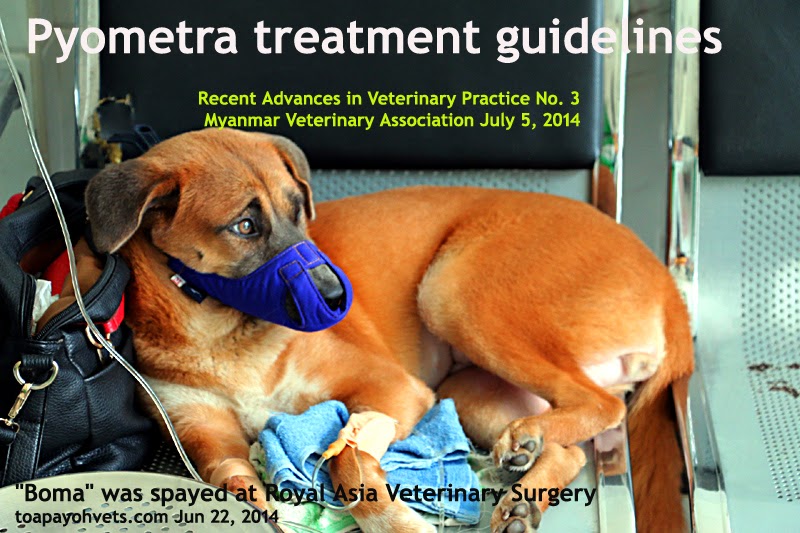The narrow diameter of the penile urethra can be blocked again. The recurrence after treatment will need to be investigated in more detail. It may be a lower urinary tract infection which has not responded to antibiotics given or the presence of uroliths in the bladder or rarely in the kidneys.
Urinalysis and urine bacterial culture and antibiotic sensitivity tests may need to be done again. Radiography of the bladder and kidneys is needed to detect the presence of radio-dense struvite bladder or the rare kidney stones. Radiography of the bladder to detect the location, number and size of the uroliths may need to be done. Ultrasonography of the bladder to view the thickness of the bladder wall, the presence of intraluminal stones or tumours will be useful in causes of recurrence.
I was visiting Dr Aung of Royal Asia Veterinary Surgery in June 2014 and videoed a case of a 4-year-old male cat with dysuria for the 3rd time being treated. The first vet had treated the cat twice, catheterising the bladder to unblock the urethra, but the dysuria recurred one week later after the second treatment. The first vet had prescribed antibiotics and a dry urine acidifying diet and sent the cat home after treatment. However the dysuria recurred and the owner sought a second opinion from Dr Aung.
GUIDELINES TO TREATMENT OF URETHRAL OBSTRUCTION IN A CAT IN TOA PAYOH VETS. The following is my procedure but my associate vet may not hospitalise the cat.
1. Radiography (2 views) of the bladder and kidneys is done. Struvite uroliths and urethral casts are radio-dense.
2. Urinalysis to check urinary pH, SG, presence of red and white blood cells and crystals. A dipstick may be used initially but a urine sample collected via urethral catherisation is sent to the laboratory.
3. CBC/Biochemistry may not be done if the owner is concerned about the medical cost.
4. The cat is sedated with an injection of combined 2% xylazine and ketamine 100mg/ml in one syringe IM. I find that the safe and effective dosage is xylazine 0.1 ml + ketamine 0.4 ml IM for a cat 2-3 kg. For a cat 3-4 kg, xylazine 0.15 ml + ketamine 0.6 ml IM.
5. The urethra is catherised as in the video. If there is urethral plug obstructing the passage of urine, around 2-10 ml of normal saline is injected to unblock the urethra. The urine is collected in a bottle for urinalysis by the laboratory. After emptying the bladder, the bladder is irrigated with over 100 ml of normal saline with the fluid syringed out to remove any urinary sand and debri.
6. The catheter is stitched to the prepuce and the cat is an inpaatient for 2 days. The catheter is removed and the cat goes home with antibiotics, tolfedine painkillers and a gradual change to an acidifying diet like the canned Science Diet C/D for one month. I prefer to give an injection of Baytril and prednisolone SC after the treatment but the younger vets may prefer non-steroidal anti-inflammatory drugs like meloxicam or tolfedine.
7. Follow up by telephone call is necessary. In this case of a 4-year-old neutered male cat treated by my associate vet Dr Daniel and sent home after the above treatment with vibravet paste and tolfedine tablets. I followed up with the owner for presentation of a Singapore cat case for this Seminar while Dr Daniel does his own follow up.
The owner told me that cat quickly removed the e-collar and pulled out the stitched catheter within one day of going home. On Day 4, he started eating and meowing for attention. But he still had urinary incontinence with a wet spot of urine on the floor. This was less than on Day 1. I prescribed another 6 days of antibiotics (Baytril) and half a tablet of prednisolone 5 mg for 8 days. She was to start on the Science Diet C/D mixing 10% with 90% of the previous food. Client education is important as the dysuria may recur if the client continues feeding the original dry food which cause alkaline urine formation. No urethral stones were seen in the bladder or kidneys in the X-rays (image in video) and triple phosphate crystals were found in the urine (image in video).
Two videos
1. Dr Aung treats a Yangon cat for urethral obstruction
2. Dr Daniel treats a Singapore cat for urethral obstruction.
-------------------------------------------------------------------------------
































